Explore the Cultural Capital of India
Undeniably, Rajasthan is endowed with an extraordinary culture, which manages to entice everyone. The major charm of the state lies in its conventionality. Even though the state has evolved a lot over time, it has maintained to keep its values intact. The art and culture of Rajasthan can be enjoyed in various forms. One can experience the charm of traditional dance forms by joining in the festivals and fairs of Rajasthan while to appreciate the craftsmanship, one can head towards markets or rural areas where a lot of handcrafted items are at sale. One can also explore the making process of handicrafts there. The architectural beauty of Rajasthan is displayed through the centuries-old palaces, forts and mansions of Rajasthan. In a nutshell, it can be affirmed that one needs to visit Rajasthan at least once to have the most memorable experience of a lifetime. Moreover, it will be fun to interact with locals and get to know about their customs and beliefs.
Witness this amazing traditional art-form of Rajasthan to believe it for yourself
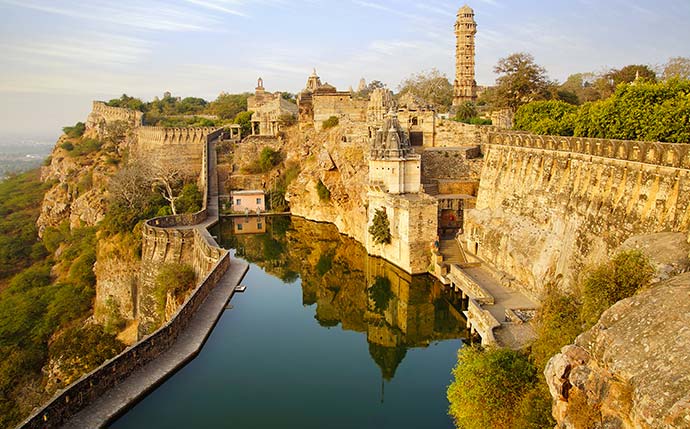
Rajasthan, one of the most sought-after destinations for domestic and international travelers, exudes an aura of royalty, culture and tradition. With varied locales to offer, ranging from hills, golden desert, lakes and forests, Rajasthan is a land of wonder. Home to the erstwhile Indian royalty, the state has many forts which are reminiscent of the rich lives and opulence of the kings and queens. Architectural marvels in themselves, the forts, temples and other historical sites leave the tourists in complete awe.
Rajasthan is known to be atleast 5000 years old with many parts being occupied by Indus Valley Civilization. Kalibunga in northern Rajasthan is one of the famous excavation sites which have revealed ancient human settlement. Rajasthan has witnessed the rule of the kings since the early 11th century upto 19th century when the British rule took over. During these years, many empires flourished in the state, leading to the development of varied architectural styles, traditions, rituals, clothing styles, cuisines and culture. Many temples, mausoleums, dargahs and forts were built during these centuries, each one outdoing the other.
Rajasthan has a collective belief in “Atithi Devo Bhava”, meaning that God resides in every guest. The people of this state are warm, indulgent and happy to assist visitors and tourists in every way. With a lot of people involved in hospitality and tourism here, one will not find any problem in travelling here.
From colourful clothes, jewellery, dances and food, it is a delight to be here.
Women like to dress in an attire called “odhni” which consists of a dupatta, blouse and a skirt. Available in different colours and materials, the dressing is attractive and vibrant. Men like to dress in kurta and pajama with a headgear called “pagdi”.
Rajasthan has varied forms of folk music and dances. One of the few folk music groups include Manganiyars, Langas, Banjaras, Mirasis and Jogis. These groups are divided because of geographical diversity and follow their own set of beliefs which are reflected in the music and performing styles. Famous dancing styles belonging to this state are Tejali, Ghoomar, Chang, Bhopa and Kathipuli. Most of these performances revolve either around sagas of bravery or love.
Rajasthan is known for its various hot spices and sweets. Famous eating items include dalbati choorma, kachori, ghewar, laal maas and more. These delectable items are traditionally prepared in pure ghee and have their roots in the royal kitchens. Spices are said to ignite the fire in the bodies of royal warriors and sweets are said to calm the mind.
Unique handicraft items like blue pottery, metal work, marble and stone statues and decoratives are famous in Rajasthan. Mirror work, embroidery, bati work and tie-and-dye are also famous here. These make for lovely souvenirs for tourists coming here.
Other than visiting the forts, tourists can visit the local markets, museums and galleries for a sneak-peak into the culture of Rajasthan. For the more adventurous ones, paragliding, desert safari, wildlife safari, camping, zip lining and hot air ballooning are also available.
Witness this amazing traditional art-form of Rajasthan to believe it for yourself
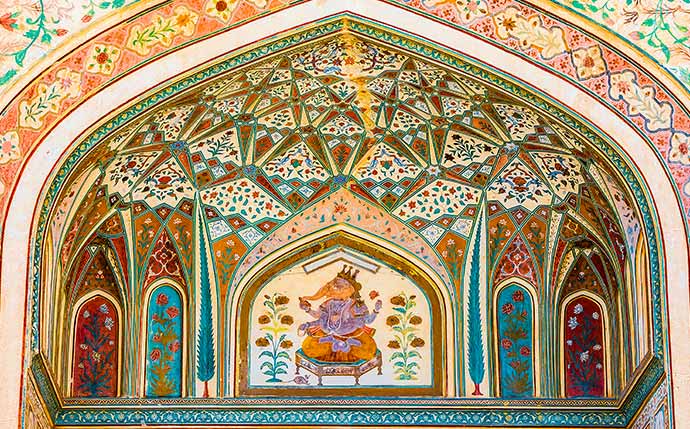
The Shekhawati region of India lies in the eastern part of the state of Rajasthan. The region is very large and has many buildings which were once where the royals of Rajasthan lived. The buildings, mostly havelis, are either abandoned or rented out to the local people
The Shekhawati region is situated in the middle of the former major trade route or the ‘SILK ROAD’ which connected the modern-day India, Pakistan and China. This benefited the local traders, called the Marwari, who built these havelis as a public show of their wealth. With the decline of the Silk Road, the Marwari’s moved on but left behind the treasure trove of the art and architecture that is their homes.
The havelis depict many themes – the daily life of the locals, gods and goddesses, folk mythology and the relatively newer buildings, those of the 19th and 20th century, depict the advent of the British. Each haveli is a piece of splendour and each has its own story to tell. The frescoes in these buildings are made with natural pigment. The oldest frescoes use ochre, red, white lead, lamp black, Indian yellow. The newer ones use synthetic pigments that were imported from Europe.
The two main towns of Mandawa and Nawalgarh have the largest concentration of havelis. Few of these havelis have preserved as museums and for a small number of rupees one can freely explore the area. There are many organisations which will help you navigate and locate the frescoes in the region.
For the most part, the frescoes depict the god and goddess and folk mythology. The meeting of the gods, the armies and their battles are all depicted in rich colours and few of them gilded in 22 karat gold leaves. The gods Ganesha and Krishna have been depicted several times over. The popular loves stories of Laila -Majnu and Heer-ranjha , the equivalent to Shakespeare’s Romeo and Juliet have been depicted, besides these, Rajasthan’ s most popular romantic tale of Dhola and Maru and also of other lesser known tales are recurrently seen. The murals depicting the Europeans have a funny undertone and are an insight into how they were viewed by the Indians there.
The art is mesmerising and indicates at a time long gone by. These frescoes are not along the usual tourist path but once there, it will be worth every minute of your time.
An Ancient art form, that will leave you spellbound by its beauty and versatility.
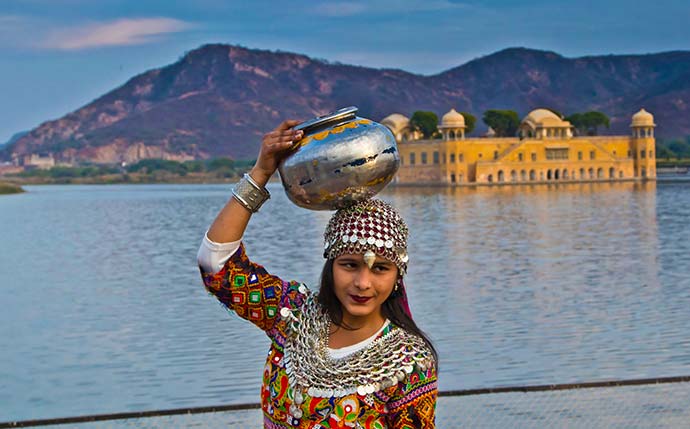
Other than the historical monuments the amazing thing to explore in Rajasthan is the market place. Markets in Rajasthan are glorious. Many different varieties of things can be found in there, people are often amazed to see how beautiful, colourful and variant those markets are.
Let us tell you about the most eye-catching product in these markets, the ethnic jewelleries. First of all, you can see people dressed in colourful ethnic outfits. Women’s mainly wear ‘Lehenga choli’ or ‘Saree’ and these outfits usually come in vibrant colours like red, orange, yellow and green or the bright shades of other colours and to compliment these bright ethnic dresses comes the ethnic jewellery. These jewelleries are not just limited for women but men in Rajasthan also wear some special jewelleries.
Speaking about jewellery there are tremendous designs patterns and works in them. There are many places where one can find the most beautiful hand-crafted bangles, bracelets, necklaces, earrings etc. These jewelleries are in different varieties, they include the use of lac, metals, precious stones, pearls, gems etc and include different methods of making them. The hand-crafted jewelleries are made by well experienced craftsmen. For certain families this is a talent which is passed on from generations to generations.
One of the most amazing type is “Kundan Minakari”. These types of jewellery are made from metal, basically minakari is the art of colouring metals by using glass. It is something like melting coloured glasses and placing them on the metal surface. The person skilled in doing this is called a “Minakar”. On the other hand, kundan work involves placing kundans on the surface. Kundans are slightly coloured transparent gems with a flat base. The reason behind the flat base is that a layer of gold is applied on it, so the gem which is already beautiful gets more shine and sparkle by the golden layer resulting in more beauty.
When these two jewellery-making forms i.e. Minakari and Kundan are combined it takes the piece of art on another level. Here, the minakari is done on a metal surface and then the kundans are placed on it. Minakari gives the glossy colours and kundans brings out the shine. These master pieces look so elegant and royal that with the right combination of the clothes and the jewellery any woman can get the feeling of a royal queen and any men can feel like the King. That’s how stunning the Jewelleries are made in Rajasthan.
You would not be able to resist yourself from falling in love with this traditional Rajasthani Art Form.
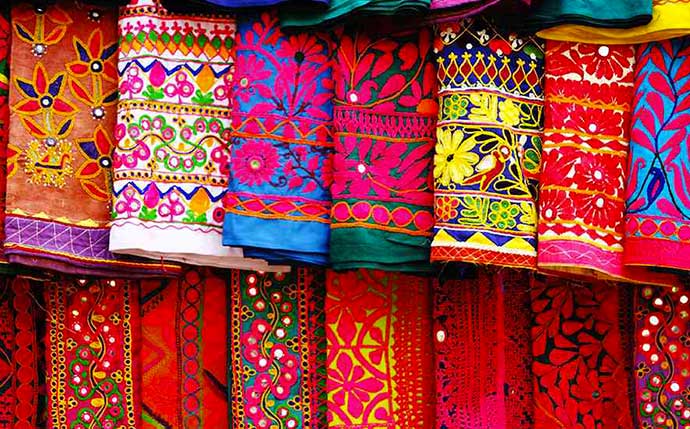
Most of the dresses in Rajasthan are vibrant in colour and have some work done on it like mirror work bandhani work or embroidery. These works are not just limited to fabrics they are also done on jewellery, shoes, hats, bags, containers and other products. Leather embroidery is one of the specialities of this State.
When exploring the markets one can notice that the most common thing in almost every product there is the embroidery. It is like the identity that the product is bought from Rajasthan. Many bright colours are used for the embroideries. There are different types of embroideries and done on different products. Rajasthani Embroidery gives everything an ethnic look and these multi coloured embroidered products matches with almost every outfit.
Leather embroidery is as the name suggests embroidery done on leather products. The animal that is most found in Rajasthan is Camel and therefore the leather used for making the leather products is obtained from camel. There is a long procedure followed to get the leather ready for making products out of it. One can find tremendous amount and varieties of leather embroidered products. “Mojdis” are a type of shoes made from leather and they have colourful embroidery done over them. Embroideried leather bags are also beautiful and can be found easily in local markets. Other leather products with embroidery done on them are bracelets, hats, jewellery boxes, belts, wallets etc. These products work great with western wears too and can also be excellent souvenir gifts to take.
The embroideries are not always randomly made designs. Some of the finest craftsmen make embroideries that shows sceneries or represents the historical kings and queens or their stories. Especially skilled craftsmen are required for these embroideries, most of the embroidery used to be handcrafted but these days machine embroidered products are used at a larger scale to increase the availability of embroidered products in the market. Machine embroidered products are low prices and can be locally found but the look and feel of the handmade embroidery is way better and incomparable to the machine embroidery.
These artworks may be small in size, but they do make a big impact!
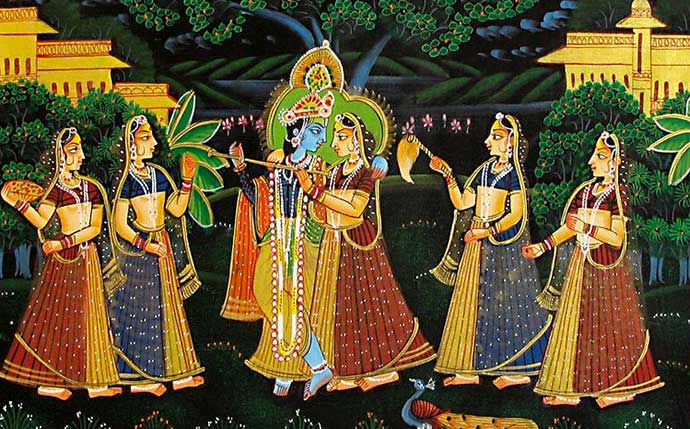
The Miniature painting of Rajasthan is an old art form known for its intricate painting and rich colours. The first evidence of this art form exists in the form of illustration of old Buddhist texts which were executed by the Palas of Northern India. The 16th century painting were presented to the rulers by their partisans as a symbol of a significant event. These were collected by rulers and displayed in their courts.
But the miniature paintings developed mostly in the Mughal period when the emperor Humayun brought Persian artists into India. The next emperor, Akbar set up a National painting school, in which an atelier for the miniature painting, artists from various parts of India trained under the Persian masters. Simultaneously several other school of painting were set up in Mewar (Udaipur), Bundi, Kotah, Marwar (Jodhpur), Bikaner, Jaipur, and Kishangarh.
The canvas of the paintings may be of paper, ivory panels, wooden tablets, leather, marble or cloth. The paints for the paintings were organic and are made by an elaborate process. The pigments were derived from vegetables, minerals and precious and semi-precious metals. Since the precision level in high, the bristles the paint brushes are very fine and are often made by using squirrel hair as bristles.
Traditionally, the paintings depict the royal families and their portraits, their various hunting expeditions and significant events and celebration. These paintings were also used for illustration of many manuscripts. During the Mughal period, we can see influences of the Persian culture in the paintings but as the art form spread the Indian influence grew stronger. This resulted in art of a different style which in now seen in the miniature paintings of Rajasthan.
The Bani Thani paintings, originating from Kishangarh district of Rajasthan is of a distinct style of people with swan like necks and almond shaped eyes. This style of painting essentially depicts the love story of Radha–Krishna. Many other tales of folk lore and festivals like Diwali and Holi are depicted in this style.
Many artists still practice this art form and use cotton, paper and cloths as canvases. The organic paints have been replaced by synthetic paints, but the paintings are still known for their rich colours and astonishing details. Tourists can try their hand at such paintings and take one home for themselves as a token of one of the oldest art form still practiced.
A tradition art-form that will leave you spellbound with its versatility.
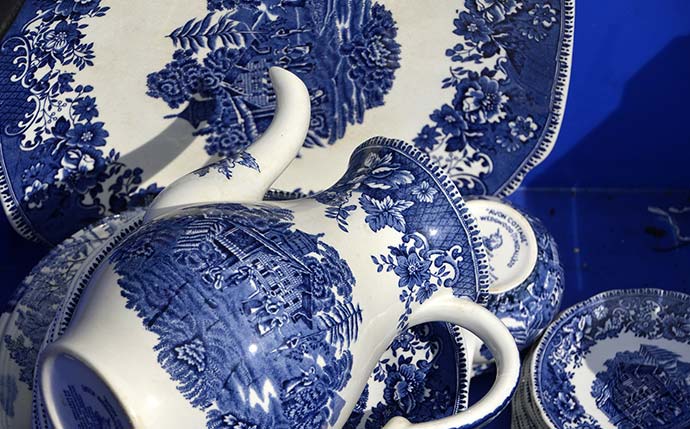
Rajasthan is a state marked by its distinct art and culture. Hand crafted products are a major speciality here and one of those specialities is Pottery. There are varieties in this category too. Some of them are Blue pottery from Jaipur, Black pottery from Sawai Madhopur, Kagzi Pottery from Alwar, Golden Pottery from Bikaner etc.
The most well-known type is Blue pottery from the capital of Rajasthan, Jaipur. The reason behind it being most popular is the royal look of these products. Normally when you hear the word pottery the image that comes in our minds is pots being made from clay, but there is a difference in this case. In blue pottery clay is not used. Yes! you read it correct. Instead of clay there are other materials used that include glass, quartz, fullers earth (known as Multani mitti in India) etc. These materials are powdered and combined together. After that, a paste/dough is made by mixing water in it and then this paste/dough is used for making vases or other wares. These vases come in different styles, designs and patterns. These beautifully shaped and carved vases are then painted by skilled and experienced craftsmen. Most of the time the paintings on them represents antient Indian culture or Indian mythological believes. Some of them even depicts stories about the kings and queens of the old era.
Other than the Blue Pottery, Black pottery is also a well-known type. Black pottery is from a city called Sawai Madhopur. The clay used for this pottery is taken from the banks of a river named Banas. The clay is first filtered by removing the unwanted waste from it. After preparation of the clay, the required shape is given, carvings/embossing is done, pots are polished and then smoked to give the black colour.
The Kagzi Pottery from the Alwar district is very interesting to know about. The name Kagzi comes from a Hindi word ‘Kagas’ meaning paper. This type of pottery is named so because it is made thin as paper. For making the paper like thin layer of clay, extreme skills are required. You might have understood how fragile and delicate the pots or vases will be if they are so thin. One can find the example of this type at some local tea stalls in that area. People are served tea in ‘Kullads’ which is a type of cup made from clay and is broken after each serving. The unique styles of Pottery in Rajasthan are popular with people from all over the world and are highly sought after.
You got to see to understand why Rajasthani Furniture is highly sought-after world over.
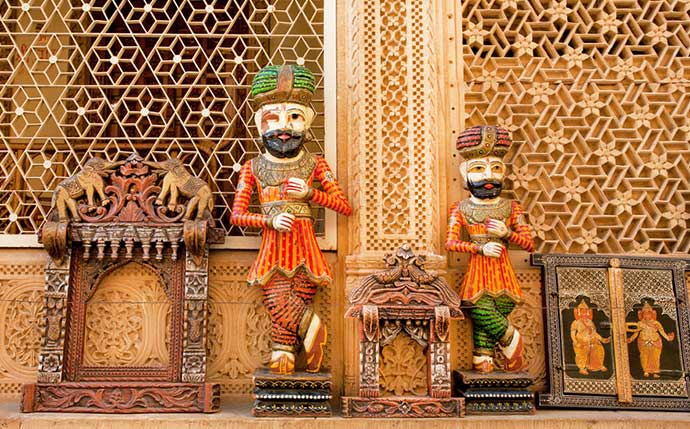
The existence of jungles in some parts of Rajasthan like Jaipur, Kota and Udaipur is what gave rise to Suthars or the carpenter class of craftsmen. Suthars either belong to the Meghwal community who are known for the cots and camels’ carts or from Barmer, who are known for their intricate craftsmanship.
In Rajasthan, being famous for a variety of crafts, wood carving was relatively lesser known because of the simple living and serious protective measures taken by ancient India. But by the support of the ruling class, this craft took up practice and craftsman of Udaipur and Bassi have made a niche for themselves in the highly competitive industries.
Wood carving was relatively well known in the medieval times. The beautiful main doors on houses of Rajasthan are a testimony to that. The wood carving was heavily inspired by Mughal art, so much so, that they are called ‘Akbari Mughal Rajput Style Doors’. Patterns in the doors show both influences of Hindu and Muslim culture, with patterns of Roses, peacocks, lotuses and parrots. The palace doors of Bikaner, Jodhpur and Jaipur deserve a special mention because of their decoration with ivory. Ever wonder at those doors in front of which travel blogger post picturesque photographs? Yup, and now you know.
The furniture industry is well developed in the city of Jaipur and Jodhpur. It produces furniture of both national and international trends. Jaipur especially uses Mango wood, Acacia wood and Shisham wood. The paintings in the furniture are another special feature. The colour scheme in the furniture is mainly traditional in an effort to bring out the cultural heritage of the place.
Rohida wood is another wood used but for making may wooden articles which also include musical instruments like the Veena. It is also used to make wooden toys. Nakshi, which is the art of wood painting, can be seen on these items. Sandalwood art forms are often in the shape of mythical creatures, animals like camels, elephants and horses.
Wood craft has evolved over the years and is a fusion between traditional and modern designs to cater to ever increasing market and wide variety of tastes. The craftsmen continue to use simple and traditional tool and techniques which in this modern world of technology give a nostalgic flavour of the old days long gone.
A traditional art-form which has created a buzz all over the world
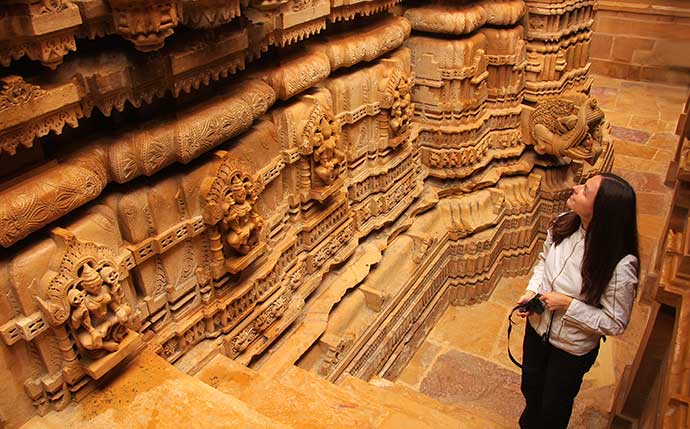
Rajasthan is a land of rich culture. It is famous for its heroes and their valorous deeds and sacrifices. It is also very famous for its architectural monuments made of stone. Rajasthan is home to temples, forts, palaces which have no competition.
Rajasthan’s rich reserve of diverse types of rocks is what attracts stone carvers to this place. Special stones such as the sand stone, lime stone, coloured and white marbles are found here.
The architecture in Jaipur grew under the Rajputs. The marble and the sandstone are used in the City Palace, Jantar Mantar ,Amer Fort, Hawa Mahal and Tripola gate in Jaipur. Jantar Mantar and Amer Fort are world Heritage sites. These architectural master pieces have been instrumental in putting the city in the world map. Jaipur forms part of the golden triangle, consisting of Delhi, Agra and Jaipur. The Golden Triangle is called so because they are three most visited places in India.
Jhodpur is another city with palace like the Ummed Bhawan and Chittar Palace, forts made with red sandstone. The perfect beauty and brilliance of the palaces will be bound to sweep you off your feet.
The city of Jaisalmer is situated in the heart of the Thar Desert is called the ‘The Rose in the Desert’ because of its red stone buildings. Places of interest include the Jaisalmer fort with its massive sandstone walls which turn into a magical honey gold as the sun sets.
Dungarpur is the fastest growing city and was the first ODF free city in Rajasthan. This city has a soft shaded stone which when oiled turns black. Places of interest include the Dev Somnath Temple. A sprawling temple, it is known for its architectural design and intricate details.
Jaipur is also known for its marble carving. The centres of Ajmer, Udaipur and Bikaner are known for their ‘jali’ work or lattices worked on screens in palaces.
Today, stone carvers have built up a industry of idol and sculpture making. This industry lies mainly in the southwest region of Jaipur. The pieces not only include gods and goddesses but also sculpture of animals, human figures and various geometric forms. The sculptures are crafted beautifully and made with such beautiful details. The sculptures seem to have a soul that the carvers seem to have put in them when they were making their masterpieces. This part of India is one you absolutely cannot miss.
BE amazed by this traditional art form of Rajasthan that is being passed down generations!
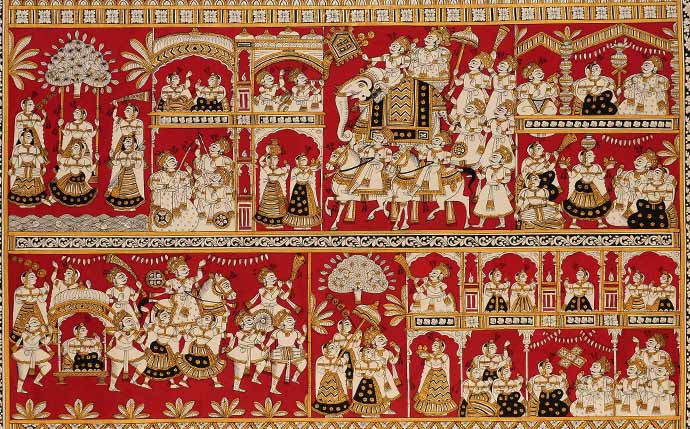
For almost 700 years ago, every evening the Bhopa and Bhopi, the priest and his wife, unroll their scrolls of Phad paintings depicting the deities and performed dramatic renditions of stories from Ramayana and Mahabharata any other mythological tales. The priest and the priestess belong to a nomadic tribe which are a tribe of camel and goat herders Originating from the Bhilwara region of Rajasthan, this tribe realising that there was no one temple they could visit, travel from village to village with their ravanhatta, a two-string instrument, performing their own form of oral worship.
Phad paintings are scroll paintings which are created on hand-woven coarse cloth. It is a complex process which takes a certain level of talent and hard work in equal proportions. The threads of the cloth are made bulkier and is starched and rubbed with moonstone to make a smooth canvas. The colours are derived from flowers and herbs and are mixes with gum which acts as a binding agent.
For the longest time, the secret of these paintings was guarded and only the Joshi family of the Chipa caste could make these paintings. But in an effort to revive the declining art form, several members of the Joshi family have begun to expand the art form and a school by the name of Chitrasahala has been established. The Phad artists are extremely skilled and use typical colours like orange for the limbs, yellow for the ornaments and red for royal clothing. The eyes are painted at the end. The artists believe that the eyes give life to the painting and it is at this point that the painting is converted into a temple.
Modern Phad paintings are now more customised keeping in mind the space limitations. They are now created for commercialisation purposes and not only when commissioned by the Bhopis and also contain text which was not seen in the traditional paintings. Since, the core of the Phad painting is storytelling, the modern artists have included different tales like of the Panchatantra, making the painting appealing to a larger audience.
The Phad paintings are a reflection of India’s rich and vibrant culture. The scroll paintings preserve the folklore and stories of India that have travelled ages. The scrolls represent a unique way of worship in a country which is already home to many of them.
Nowhere else will you get to see the amazing handiwork of true artists of Rajasthan.
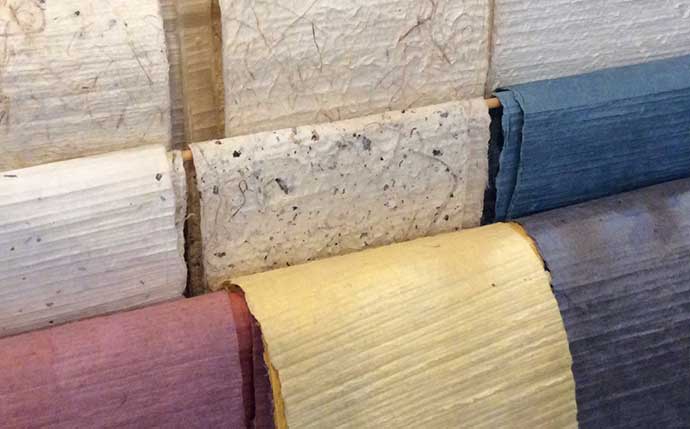
Paper making industry is another interesting thing to know about Rajasthan. The art of making paper was given importance in those areas by the Mughal emperors centuries ago. This paper making industry is quite different from other paper making industries. A lot of factors make it different from others. The prime factor here is that its eco- friendly.
These papers are also handcrafted for preparing pots and jewelleries and other artistic things. These handcrafted papers also have various types and varieties in them. Some are regular papers some are embossed and then there is cardboard and other hundreds of types of papers. These types of paper are used for numerous purposes like making books, Diaries, gift papers, coloured papers, greeting cards, boxes, designed wrapping papers, paper bags and many more products can be made from these papers.
The paper making industry here uses recycled products for making the paper, mostly they use the waste products from the cotton industries and make paper out of it. They also use other organic products like flower petals leaves and other remains in the process. Also, they reuse the remains of cottons left from the first time of paper making process for the next time. One more interestingly eco-friendly fact is that the water they use in the first-time paper making process is also reused again for the next time and again and again till it can’t be used again. In this way they are making use of each and every raw material to its fullest and till its reusable. Therefore, leaving almost nothing as a waste.
The obvious plus point in their paper making technique is that no trees are harmed in the process. Not only the process of making these papers is eco-friendly but also the paper itself is recyclable. The paper making industries in Rajasthan have reached to the global markets by now. These industries are making a huge contribution in overall environmental development.